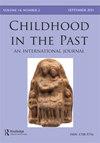Editorial
IF 0.5
Q3 ANTHROPOLOGY
引用次数: 1
Abstract
Welcome to Part 2 of Volume 11 of Childhood in the Past, the journal of the Society for the Study of Childhood in the Past (SSCIP). This issue includes four research papers and three book reviews. The volume commences with a paper by Mélie Le Roy, Stéphane Rottier and Anne-Marie Tillier that asks: ‘Who was a “Child” During the Neolithic in France?’. The study focuses on juvenile remains recovered from Neolithic (5700–2100 BC) tombs and investigates funerary practices, age distribution and burial location to determine the place of children within the different cultural groups of the Early, Middle and Later Neolithic in both northern and southern France. Young children seem to be under-represented across the entire Neolithic throughout France and ethnographic data is called upon to help explain this phenomenon. Four different forms of age selection are identified in relation to the juveniles contained within collective burials. The paper of Emma Harper discusses the contribution that artefacts recorded by the Portable Antiquities Scheme, which encourages the voluntary recording of archaeological objects in England andWales, can make to discussions of later mediaeval childhood. The study focuses on objects that have been identified as toys, and particularly those described as figures or dolls. Drawing upon evidence derived from theoretical discussions of past childhood, archaeological excavations and contemporary written and artistic accounts, she argues that the various characteristics of the dolls are suggestive of both the imposition of behaviours upon children by adults but also the direct agency of children. While contemporary documentary sources have a tendency to yield information about the play items of children from elite families, the material record has the advantage of providing a more balanced perspective since objects used for play among the lower classes of society have also been discovered. Olga Boitsova and Ekaterina Orekh investigate the significance of colour in children’s clothing in relation to the Soviet ideology of childhood in Russia. Their analysis focuses on data contained within twentieth-century Soviet advice books, brochures and thematic articles in fashion magazines, as well as postcards and illustrations from school books. They discuss how the colours evident in children’s clothing can be linked to a history of ideas, particularly in relation to issues such as gender. Their evidence suggests that children were viewed in a genderneutral, asexual manner in Soviet Russia, a perspective that did not change until the 1980s when genderization of clothing images was first observed. Up until this point official discourse on children’s clothes was unanimous and light colours, including pink, were considered markers of childhood for both boys and girls. In his paper, Ian Waites uses a selection of photographs taken in the early 1970s of children on a post-World War Two British council estate in Gainsborough, Lincolnshire, as a means of understanding the nature of life for these children. Having grown up on the Middlefield Lane estate included in the paper, Waites provides a poignant first-hand review of how the planning and layout of the estate was intended to function as a crucial influence on the development of the children who lived there. He suggests that children were often included in the photographs to promote a sense of well-being and community within these estates that were considered one of the cornerstones of post-war social reconstruction in Britain.社论
欢迎收看过去的童年研究学会(SSCIP)期刊《过去的童年》第11卷第2部分。本期包括四篇研究论文和三篇书评。该卷以Mélie Le Roy、Stéphane Rottier和Anne Marie Tillier的一篇论文开头,该论文问道:“谁是法国新石器时代的“孩子”?”。这项研究的重点是从新石器时代(公元前5700年至2100年)坟墓中发现的青少年遗骸,并调查了埋葬方式、年龄分布和埋葬地点,以确定法国北部和南部新石器时代早期、中期和晚期不同文化群体中儿童的位置。在整个法国新石器时代,幼儿的代表性似乎不足,民族志数据被用来帮助解释这一现象。根据集体埋葬的青少年,确定了四种不同的年龄选择形式。Emma Harper的论文讨论了便携式文物计划(Portable Antiquities Scheme)记录的文物对中世纪晚期儿童的讨论所做的贡献,该计划鼓励英格兰和威尔士自愿记录考古物品。这项研究的重点是那些被认定为玩具的物体,尤其是那些被描述为人物或玩偶的物体。根据对过去童年的理论讨论、考古发掘以及当代书面和艺术描述中得出的证据,她认为,玩偶的各种特征既暗示了成年人对儿童的强加行为,也暗示了儿童的直接能动性。虽然当代文献来源倾向于提供有关精英家庭儿童游戏项目的信息,但材料记录的优势在于提供了一个更平衡的视角,因为社会下层用于游戏的对象也被发现了。奥尔加·博伊佐娃(Olga Boitsova)和叶卡捷琳娜·奥列赫(Ekaterina Orekh)研究了俄罗斯儿童服装颜色与苏联童年意识形态的关系。他们的分析重点是20世纪苏联的咨询书、时尚杂志上的小册子和主题文章中的数据,以及学校书籍中的明信片和插图。他们讨论了童装中明显的颜色如何与思想史联系起来,特别是在性别等问题上。他们的证据表明,在苏俄,人们以中性、无性的方式看待儿童,直到20世纪80年代首次观察到服装图像的性别化,这种观点才改变。在这之前,官方对童装的讨论是一致的,包括粉色在内的浅色被认为是男孩和女孩童年的标志。Ian Waites在他的论文中使用了一组20世纪70年代初在林肯郡Gainsborough的二战后英国议会庄园拍摄的儿童照片,作为了解这些儿童生活本质的一种手段。Waites在论文中提到的Middlefield Lane庄园长大,他对庄园的规划和布局如何对居住在那里的孩子的发展产生关键影响进行了深刻的第一手回顾。他建议,照片中经常包括儿童,以促进这些庄园的幸福感和社区感,这些庄园被认为是英国战后社会重建的基石之一。
本文章由计算机程序翻译,如有差异,请以英文原文为准。
求助全文
约1分钟内获得全文
求助全文
来源期刊

Childhood in the Past
Social Sciences-Anthropology
CiteScore
0.90
自引率
0.00%
发文量
16
期刊介绍:
Childhood in the Past provides a peer-reviewed, interdisciplinary, international forum for the publication of research into all aspects of children and childhood in the past, which transcends conventional intellectual, disciplinary, geographical and chronological boundaries. The editor welcomes offers of papers from any field of study which can further knowledge and understanding of the nature and experience of childhood in the past.
 求助内容:
求助内容: 应助结果提醒方式:
应助结果提醒方式:


